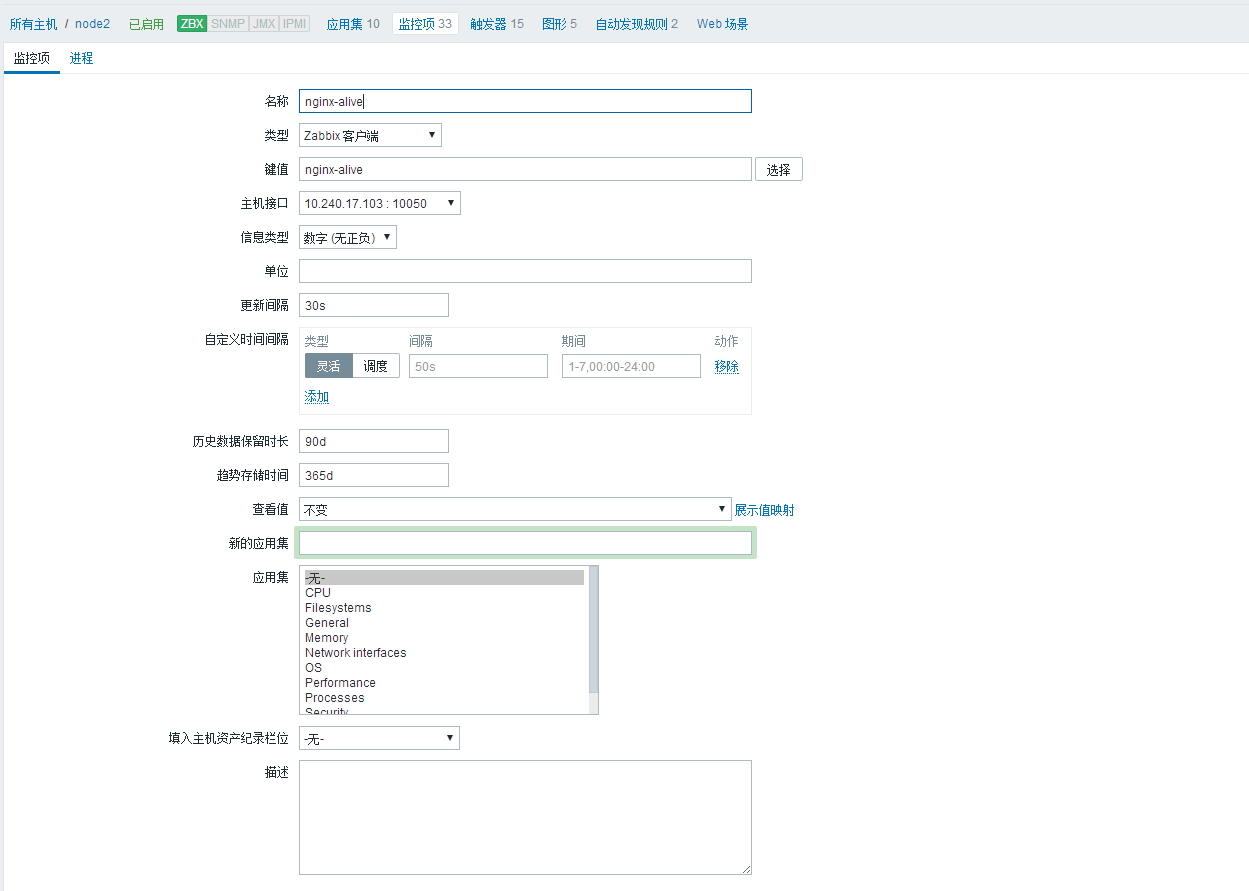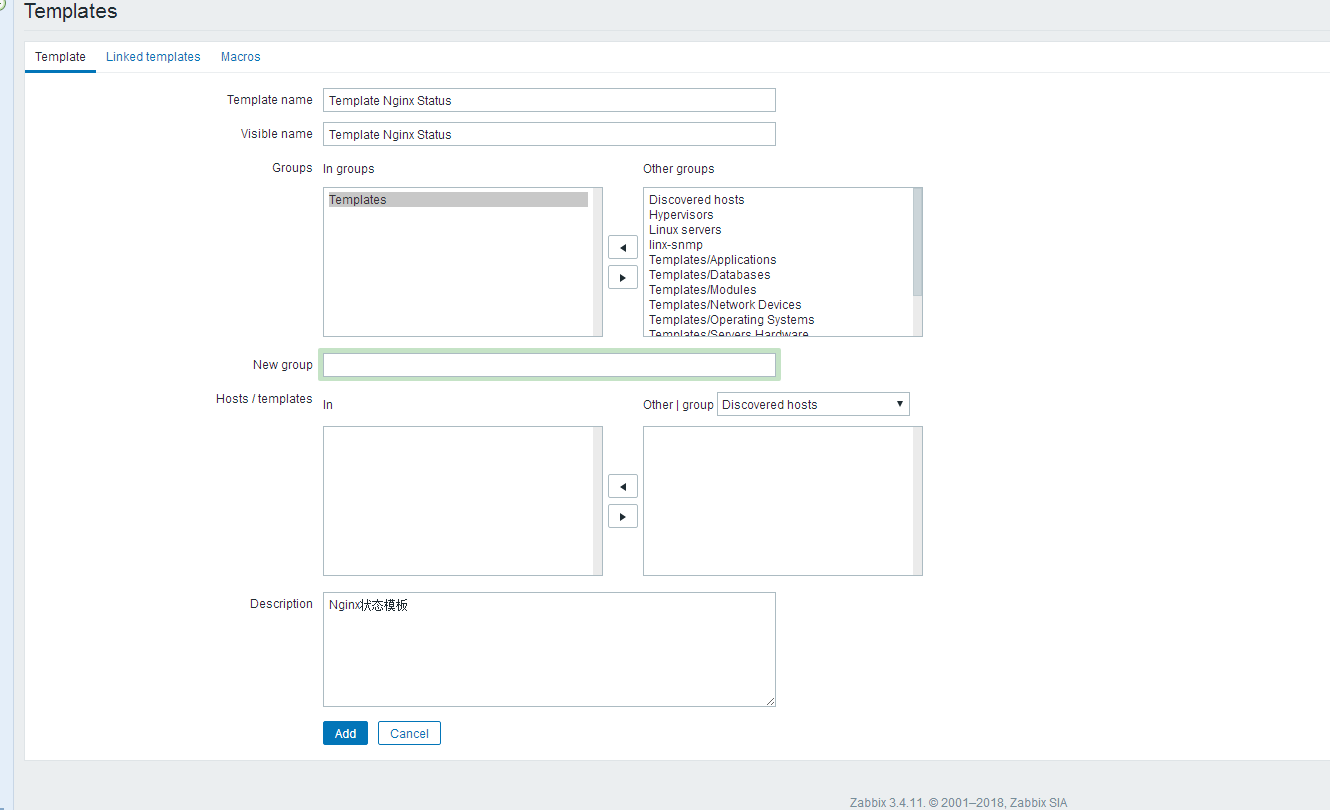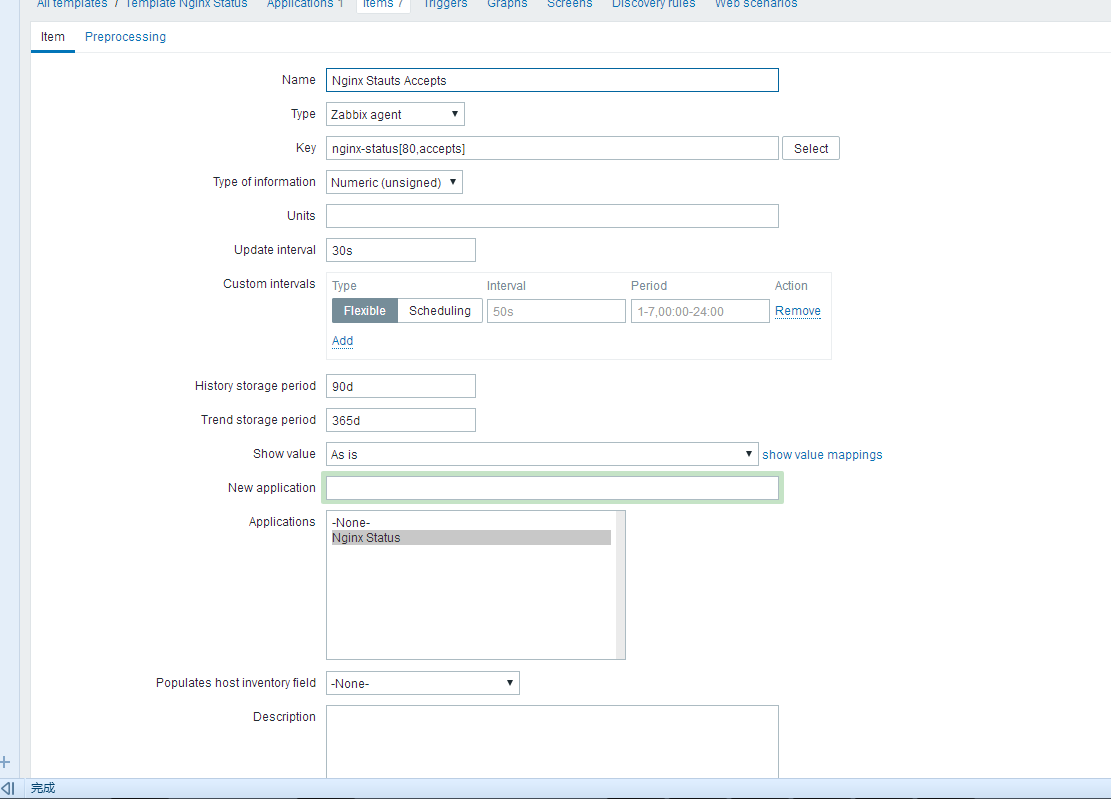自动化zabbix-(1)

[root@linux-node1 ~]# yum -y install mariadb mariadb-server php php-mysql httpd 已安装: httpd.x86_64 0:2.4.6-67.el7.centos.5 mariadb.x86_64 1:5.5.56-2.el7 mariadb-server.x86_64 1:5.5.56-2.el7 php.x86_64 0:5.4.16-42.el7 php-mysql.x86_64 0:5.4.16-42.el7 作为依赖被安装: httpd-tools.x86_64 0:2.4.6-67.el7.centos.5 libzip.x86_64 0:0.10.1-8.el7 mailcap.noarch 0:2.1.41-2.el7 perl-Compress-Raw-Bzip2.x86_64 0:2.061-3.el7 perl-Compress-Raw-Zlib.x86_64 1:2.061-4.el7 perl-DBD-MySQL.x86_64 0:4.023-5.el7 perl-DBI.x86_64 0:1.627-4.el7 perl-IO-Compress.noarch 0:2.061-2.el7 perl-Net-Daemon.noarch 0:0.48-5.el7 perl-PlRPC.noarch 0:0.2020-14.el7 php-cli.x86_64 0:5.4.16-42.el7 php-common.x86_64 0:5.4.16-42.el7 php-pdo.x86_64 0:5.4.16-42.el7 作为依赖被升级: mariadb-libs.x86_64 1:5.5.56-2.el7 完毕! [root@linux-node1 ~]# systemctl enable mariadb Created symlink from /etc/systemd/system/multi-user.target.wants/mariadb.service to /usr/lib/systemd/system/mariadb.service. [root@linux-node1 ~]# systemctl start mariadb [root@linux-node1 ~]# mysql_secure_installation NOTE: RUNNING ALL PARTS OF THIS SCRIPT IS RECOMMENDED FOR ALL MariaDB SERVERS IN PRODUCTION USE! PLEASE READ EACH STEP CAREFULLY! In order to log into MariaDB to secure it, we'll need the current password for the root user. If you've just installed MariaDB, and you haven't set the root password yet, the password will be blank, so you should just press enter here. Enter current password for root (enter for none): #输入root密码(第一次按回车设置root密码) Set root password? [Y/n] y #是否设置root密码 New password: Re-enter new password: Password updated successfully! Reloading privilege tables.. ... Success! Remove anonymous users? [Y/n] y #是否删除匿名用户 Disallow root login remotely? [Y/n] n #是否禁用root远程登录 Remove test database and access to it? [Y/n] y #是否删除测试库并访问它 Reload privilege tables now? [Y/n] y #是否现在加载权限表 #创建zabbix数据库及其用户 [root@linux-node1 ~]# mysql -uroot -p'******' -e "create database zabbix default character set utf8 collate utf8_bin;" [root@linux-node1 ~]# mysql -uroot -p'******' -e "grant all on zabbix.* to 'zabbix'@'%' identified by 'zabbix';" [root@linux-node1 ~]# mysql -uzabbix -pzabbix Welcome to the MariaDB monitor. Commands end with ; or \g. Your MariaDB connection id is 16 Server version: 5.5.56-MariaDB MariaDB Server Copyright (c) 2000, 2017, Oracle, MariaDB Corporation Ab and others. Type 'help;' or '\h' for help. Type '\c' to clear the current input statement. MariaDB [(none)]> show databases; +--------------------+ | Database | +--------------------+ | information_schema | | zabbix | +--------------------+ 2 rows in set (0.00 sec) MariaDB [(none)]> [root@linux-node1 ~]# systemctl start httpd [root@linux-node1 ~]# netstat -lntup Active Internet connections (only servers) Proto Recv-Q Send-Q Local Address Foreign Address State PID/Program name tcp 0 0 0.0.0.0:3306 0.0.0.0:* LISTEN 3010/mysqld tcp 0 0 0.0.0.0:22 0.0.0.0:* LISTEN 1486/sshd tcp 0 0 127.0.0.1:25 0.0.0.0:* LISTEN 2631/master tcp6 0 0 :::80 :::* LISTEN 8152/httpd tcp6 0 0 :::22 :::* LISTEN 1486/sshd tcp6 0 0 ::1:25 :::* LISTEN 2631/master [root@linux-node1 ~]# rpm -ivh http://repo.zabbix.com/zabbix/3.4/rhel/7/x86_64/zabbix-release-3.4-2.el7.noarch.rpm 获取http://repo.zabbix.com/zabbix/3.4/rhel/7/x86_64/zabbix-release-3.4-2.el7.noarch.rpm 警告:/var/tmp/rpm-tmp.vEGLOj: 头V4 RSA/SHA512 Signature, 密钥 ID a14fe591: NOKEY 准备中... ################################# [100%] 正在升级/安装... 1:zabbix-release-3.4-2.el7 ################################# [100%] [root@linux-node1 ~]# yum -y install zabbix-server-mysql zabbix-web-mysql zabbix-get 已安装: zabbix-get.x86_64 0:3.4.3-1.el7 zabbix-server-mysql.x86_64 0:3.4.3-1.el7 zabbix-web-mysql.noarch 0:3.4.3-1.el7 作为依赖被安装: OpenIPMI-libs.x86_64 0:2.0.19-15.el7 OpenIPMI-modalias.x86_64 0:2.0.19-15.el7 dejavu-fonts-common.noarch 0:2.33-6.el7 dejavu-sans-fonts.noarch 0:2.33-6.el7 fontpackages-filesystem.noarch 0:1.44-8.el7 fping.x86_64 0:3.10-4.el7 iksemel.x86_64 0:1.4-6.el7 libX11.x86_64 0:1.6.5-1.el7 libX11-common.noarch 0:1.6.5-1.el7 libXau.x86_64 0:1.0.8-2.1.el7 libXpm.x86_64 0:3.5.12-1.el7 libevent.x86_64 0:2.0.21-4.el7 libpng.x86_64 2:1.5.13-7.el7_2 libtool-ltdl.x86_64 0:2.4.2-22.el7_3 libxcb.x86_64 0:1.12-1.el7 libxslt.x86_64 0:1.1.28-5.el7 net-snmp-libs.x86_64 1:5.7.2-28.el7 php-bcmath.x86_64 0:5.4.16-42.el7 php-gd.x86_64 0:5.4.16-42.el7 php-ldap.x86_64 0:5.4.16-42.el7 php-mbstring.x86_64 0:5.4.16-42.el7 php-xml.x86_64 0:5.4.16-42.el7 t1lib.x86_64 0:5.1.2-14.el7 unixODBC.x86_64 0:2.3.1-11.el7 zabbix-web.noarch 0:3.4.3-1.el7 完毕! #导入zabbix数据库结构 [root@linux-node1 ~]# cd /usr/share/doc/zabbix-server-mysql-3.4.3/ [root@linux-node1 zabbix-server-mysql-3.4.3]# zcat create.sql.gz | mysql -uroot -p'******' zabbix #修改zabbix sever的配置文件 [root@linux-node1 ~]# vim /etc/zabbix/zabbix_server.conf DBHost=localhost DBName=zabbix DBUser=zabbix DBPassword=zabbix #定义php的时区 [root@linux-node1 ~]# vim /etc/httpd/conf.d/zabbix.conf php_value date.timezone Asia/Chongqing #zabbix-server加入开机启动,并启动zabbix-server [root@linux-node1 ~]# systemctl enable zabbix-server Created symlink from /etc/systemd/system/multi-user.target.wants/zabbix-server.service to /usr/lib/systemd/system/zabbix-server.service. [root@linux-node1 ~]# systemctl start zabbix-server #重启apache [root@linux-node1 ~]# systemctl restart httpd 访问http://192.168.56.11/zabbix/setup.php这个地址 [root@linux-node1 ~]# vim /etc/httpd/conf.d/zabbix.conf Alias /zabbix /usr/share/zabbix #/zabbix可自定义位置,修改完毕后需重启apache
数据采集
本地 远程
agent-->>server 2种方式,1种是server轮训方式,2是客户端主动发给server
######SNMP#######
[root@node1]#yum install -y net-snmp net-snmp-libs net-snmp-utils -y
[root@node1]#vim /etc/snmp/snmpd.conf
com2sec admin default admin
group admin v2c admin
view admin included .1 80
access admin "" any noauth exact admin admin none
[root@node1]# netstat -nulp |grep 161
[root@node1]# snmpget -v2c -c admin 10.240.17.100 .1.3.6.1.4.1.2021.10.1.3.1
在监控页面上----configuration---host---create host----

然后添加模版---Templates--选择模版Template OS LINUX SNMP-V2 ---Add ----Add------点Macros---输入{$SNMP_COMMUNITY}=admin----Add
https://yq.aliyun.com/articles/293215?spm=5176.100239.blogcont38837.25.2b8b6e57comiq9 邮件发送报警设置
配置nginx--监控存活状态
[root@node2]#yum install nginx -y
[root@node2]#vim /etc/zabbix/zabbix_agentd.conf
243 Include=/etc/zabbix_agentd.conf.d/
255 UnsafeUserParameters=1
[root@node2]#/etc/init.d/zabbix_agentd restart
[root@node2]#vim /etc/zabbix_agentd.conf.d/zabbix-nginx.conf
UserParameter=nginx-alive,curl --head -s http://10.240.17.103/ |grep '200 ok' |wc -l
[root@node1]#yum install zabbix-get -y
[root@node1]#zabbix_get 10.240.17.103 -k nginx-alive
在页面----configuration---hosts---node2----items----create items----


--创建触发器--configuration----node2Triggers----create triggers---

[root@node2]#vim nginx.conf
1 2 3 4 5 6 7 8 9 | server{ server_name 127.0.0.1; location /nginx_status { stub_status on; access_log off; allow 127.0.0.1; deny all; }}<br><br>/data/ops/app/nginx -s reload |
[root@node2]#curl http://127.0.0.1/nginx_status
[root@node2]# vim /etc/zabbix/zabbix_nginx_plugin.sh
1 2 3 4 5 6 7 8 9 10 11 12 13 14 15 16 17 18 19 20 21 22 23 24 25 26 27 28 29 30 31 32 33 34 35 36 37 38 39 40 41 42 43 44 45 46 47 48 49 50 | #!/bin/bashNGINX_PORT=$1nginx_active(){ /usr/bin/curl "http://127.0.0.1:"$NGINX_PORT"/nginx_status/" 2>/dev/null|grep 'Active'|awk '{print $3}' }nginx_reading(){ /usr/bin/curl "http://127.0.0.1:"$NGINX_PORT"/nginx_status/" 2>/dev/null|grep 'Reading'|awk '{print $2}'}nginx_writing(){ /usr/bin/curl "http://127.0.0.1:"$NGINX_PORT"/nginx_status/" 2>/dev/null|grep 'Writing'|awk '{print $4}'}nginx_waiting(){ /usr/bin/curl "http://127.0.0.1:"$NGINX_PORT"/nginx_status/" 2>/dev/null|grep 'Waiting'|awk '{print $2}'}nginx_accepts(){ /usr/bin/curl "http://127.0.0.1:"$NGINX_PORT"/nginx_status/" 2>/dev/null|awk NR==3|awk '{print $1}'}nginx_handled(){ /usr/bin/curl "http://127.0.0.1:"$NGINX_PORT"/nginx_status/" 2>/dev/null|awk NR==3|awk '{print $2}'}nginx_requests(){ /usr/bin/curl "http://127.0.0.1:"$NGINX_PORT"/nginx_status/" 2>/dev/null|awk NR==3|awk '{print $3}'}mail() { case $2 in active) nginx_active; ;; reading) nginx_reading; ;; writing) nginx_writing; ;; waiting) nginx_waiting; ;; accepts) nginx_accepts; ;; handled) nginx_handled; ;; requests) nginx_requests; esac}mail $1 $2 |
vim zabbix-nginx.conf
UserParameter=nginx-status[*],/etc/zabbix/zabbix_nginx_plugin.sh "$1" "$2"
[root@node1]#zabbix_get -s 10.240.17.103 -k nginx-status[80,accepts]
创建自定义模板----configuration--Templates---create templates----add

然后点进模板---APPlic ations---create 添加Nginx Status---点items--create item------
---克隆添加7次----configuration--hosts----
---add----update 至此 模板创建添加成功。
创建图形--- configuration---Template找到nginx模板-----Graphs---create graphs --
----Screens----All screens-----create screens---
Constructor--- 添加change--add 最终添加完成

#!/bin/bash ############################################################ # $Name: zabbix_linux_plugins.sh # $Version: v1.0 # $Function: zabbix plugins # $Author: Jason Zhao # $organization: www.unixhot.com # $Create Date: 2014-08-10 # $Description: Monitor Linux Service Status ############################################################ tcp_status_fun(){ TCP_STAT=$1 #netstat -n | awk '/^tcp/ {++state[$NF]} END {for(key in state) print key,state[key]}' > /tmp/netstat.tmp ss -ant | awk 'NR>1 {++s[$1]} END {for(k in s) print k,s[k]}' > /tmp/netstat.tmp TCP_STAT_VALUE=$(grep "$TCP_STAT" /tmp/netstat.tmp | cut -d ' ' -f2) if [ -z $TCP_STAT_VALUE ];then TCP_STAT_VALUE=0 fi echo $TCP_STAT_VALUE } nginx_status_fun(){ NGINX_PORT=$1 NGINX_COMMAND=$2 nginx_active(){ /usr/bin/curl "http://127.0.0.1:"$NGINX_PORT"/nginx_status/" 2>/dev/null| grep 'Active' | awk '{print $NF}' } nginx_reading(){ /usr/bin/curl "http://127.0.0.1:"$NGINX_PORT"/nginx_status/" 2>/dev/null| grep 'Reading' | awk '{print $2}' } nginx_writing(){ /usr/bin/curl "http://127.0.0.1:"$NGINX_PORT"/nginx_status/" 2>/dev/null| grep 'Writing' | awk '{print $4}' } nginx_waiting(){ /usr/bin/curl "http://127.0.0.1:"$NGINX_PORT"/nginx_status/" 2>/dev/null| grep 'Waiting' | awk '{print $6}' } nginx_accepts(){ /usr/bin/curl "http://127.0.0.1:"$NGINX_PORT"/nginx_status/" 2>/dev/null| awk NR==3 | awk '{print $1}' } nginx_handled(){ /usr/bin/curl "http://127.0.0.1:"$NGINX_PORT"/nginx_status/" 2>/dev/null| awk NR==3 | awk '{print $2}' } nginx_requests(){ /usr/bin/curl "http://127.0.0.1:"$NGINX_PORT"/nginx_status/" 2>/dev/null| awk NR==3 | awk '{print $3}' } case $NGINX_COMMAND in active) nginx_active; ;; reading) nginx_reading; ;; writing) nginx_writing; ;; waiting) nginx_waiting; ;; accepts) nginx_accepts; ;; handled) nginx_handled; ;; requests) nginx_requests; esac } memcached_status_fun(){ M_PORT=$1 M_COMMAND=$2 echo -e "stats\nquit" | nc 127.0.0.1 "$M_PORT" | grep "STAT $M_COMMAND " | awk '{print $3}' } redis_status_fun(){ R_PORT=$1 R_COMMAND=$2 (echo -en "INFO \r\n";sleep 1;) | nc 127.0.0.1 "$R_PORT" > /tmp/redis_"$R_PORT".tmp REDIS_STAT_VALUE=$(grep ""$R_COMMAND":" /tmp/redis_"$R_PORT".tmp | cut -d ':' -f2) echo $REDIS_STAT_VALUE } main(){ case $1 in tcp_status) tcp_status_fun $2; ;; nginx_status) nginx_status_fun $2 $3; ;; memcached_status) memcached_status_fun $2 $3; ;; redis_status) redis_status_fun $2 $3; ;; *) echo $"Usage: $0 {tcp_status key|memcached_status key|redis_status key|nginx_status key}" esac } main $1 $2 $3




【推荐】国内首个AI IDE,深度理解中文开发场景,立即下载体验Trae
【推荐】编程新体验,更懂你的AI,立即体验豆包MarsCode编程助手
【推荐】抖音旗下AI助手豆包,你的智能百科全书,全免费不限次数
【推荐】轻量又高性能的 SSH 工具 IShell:AI 加持,快人一步
· 10年+ .NET Coder 心语,封装的思维:从隐藏、稳定开始理解其本质意义
· .NET Core 中如何实现缓存的预热?
· 从 HTTP 原因短语缺失研究 HTTP/2 和 HTTP/3 的设计差异
· AI与.NET技术实操系列:向量存储与相似性搜索在 .NET 中的实现
· 基于Microsoft.Extensions.AI核心库实现RAG应用
· TypeScript + Deepseek 打造卜卦网站:技术与玄学的结合
· 阿里巴巴 QwQ-32B真的超越了 DeepSeek R-1吗?
· 【译】Visual Studio 中新的强大生产力特性
· 10年+ .NET Coder 心语 ── 封装的思维:从隐藏、稳定开始理解其本质意义
· 【设计模式】告别冗长if-else语句:使用策略模式优化代码结构